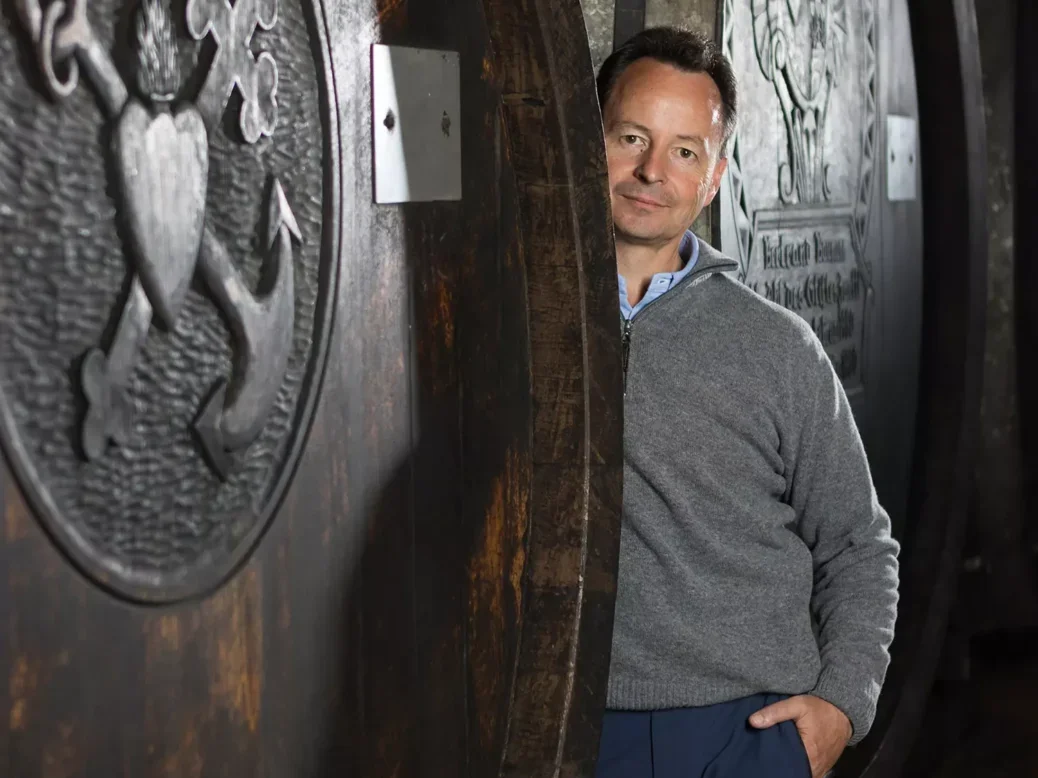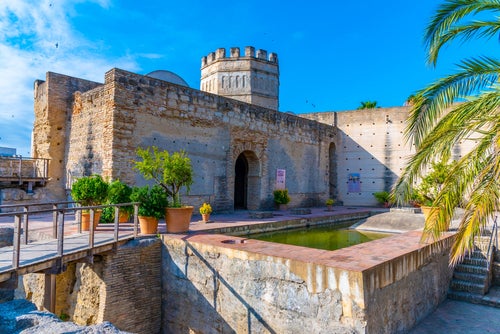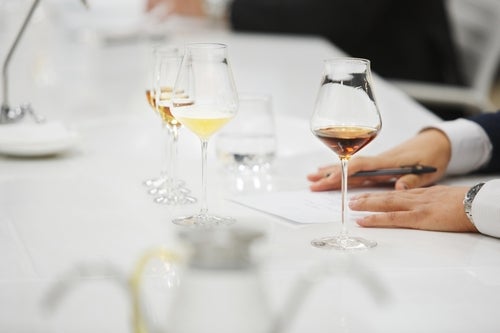
Margaret Rand meets Michael Moosbrugger, the brilliant natural diplomat who has overseen the modern transformation of the historic Austrian estate, Schloss Gobelsburg.
The word to describe Michael Moosbrugger, if I had to pick just one, would be “calm.” He has the sort of unruffled demeanor that you associate with somebody running a top hotel; no celebrity demand could ever fluster him, no staff crisis ever warrant hurling a telephone at the wall. So, when he says that, yes, his family does own a hotel, a Relais & Châteaux hotel in the west of Austria, and that his father was a co-founder of the first sommelier association in Austria, everything falls into place. “I am naturally diplomatic,” he agrees. “My wife always tells me I’m too polite to people.” She, though, can have her non-diplomatic moments, he says—“It’s how we cope together.”
His father died when Michael was 22—of hypoxia during an expedition to the Himalayas. Suddenly everybody had to manage. There were three children, and their mother decided that Michael would have to run the wine side of the hotel. He was at university at the time, reading philosophy, psychology, law, and music sciences, and he “would probably still be there if this hadn’t happened.” Music is still important to him; he played three instruments until he was 20, and considered the Mozarteum University in Salzburg for a while. He still plays the piano for an hour each day. He loves jazz, Bach, Chopin, Schubert, Brahms; he plays folk music with members of the Vienna Philharmonic; and as we will see, opera changed his life.
But for the moment, wine was about to change his life. There’s no obvious connection between those two strands, philosophy and wine, though that background does explain his ability to look below the surface of any question. In academia, he says, “You have to look at details. In marketing—especially in luxury marketing—it’s an advantage to see things in black and white.”
Whether he’s in the luxury market now is a question for later; for the moment, back from university, he was put in charge of the hotel’s beverage department, organizing all the wines, the buying, and the administration. “We made an agreement that at least one of us must be at home while the other two continued their education. So, after a couple of years, when we had all finished our education, we could decide on the future of the hotel. I was the oldest, so I had the first choice.” The hotel had evolved from his grandparents’ small farmhouse into a three- or four-star hotel, and then, under his parents, to five stars. “What is my vision of the hotel for the next 30 years?” he asked himself and didn’t really have an answer. He wanted to start something from scratch. “I told my mother that I believed my brother was better suited to the hotel and that I would like to do something else. He took over, and I went to Lower Austria.”
The attraction of Lower Austria was wine. There had always been wine at home, and the point of his father’s sommelier association was to do tastings, visit wineries, and widen knowledge; the cellar at home was full of great names, at a time when Austrian wine was mostly inward-looking. To begin with, Michael thought he wanted to study agriculture in general but then realized that, actually, it was wine that interested him. So, he went to work for the likes of Jamek and Salomon (running a top hotel gives you a good contacts book) and began to look out for his own project.
Going to Gobelsburg
Schloss Gobelsburg was hardly a project to start from scratch, it is true. It had been there since 1171, and since 1740 it had been owned by the Cistercian monastery of Stift Zwettl, about half an hour to the north. Father Bertrand had been the administrator from 1958 to 1980, when he became abbot and moved to Stift Zwettl. He appointed Karl Burger, the son of a local farmer, to run it, and in 1990 Burger was replaced by Andreas Schmid. But Father Bertrand wanted a long-term solution.
Gobelsburg had always been one of the leading estates in Kamptal, with wonderful parcels in Lamm, Heiligenstein, and Gaisberg, among others. In the 1980s, pre-scandal, its wines stood out because they had that extra something; call it great terroir. It survived the scandal because it made Mass wine. Father Bertrand reminded people that Mass wine could not be adulterated, and as a result, at a time when people in Vienna didn’t know what they could and couldn’t drink, Gobelsburg could barely keep up with demand.
This was good in one way, but after the scandal, when new names and a new generation came to the fore with an emphasis on crus, Gobelsburg risked being left behind because it wasn’t in trouble and had no need to look at future development. But Father Bertrand still needed long-term management.
The two strands—Father Bertrand’s needs and Michael Moosbrugger’s wishes—came together during a December telephone call from Willi Bründlmayer. Moosbrugger had asked Bründlmayer, along with everyone else he knew, to keep an ear out for suitable projects, and Bründlmayer had heard of one. It wasn’t one he wanted to do himself, he told Moosbrugger, though he would take a share. But he wouldn’t interfere as long as the wines were as good as or better than his own. This, remarks Moosbrugger, was an incentive.
This was in December 1995. On December 30, Moosbrugger visited the estate for the first time. “Two weeks later, I moved in. Really good things go very quickly.” He took a lease for two generations on the whole property, including the 18th-century schloss, which of course came with all the problems of upkeep that 18th-century schlossen tend to have. How much did he pay? “It was a fair deal,” he says, diplomatically.
“We invested everything out of the operation, so financially we’re quite well off now, and we’ve invested about €6 million over the past three years—long-term investments in the cellar, that sort of thing.” A new cellar was unveiled for the estate’s 850th anniversary in 2021.
One of the first things to do was meet the estate’s clients. Among these was the Hilton Vienna Stadtpark—a long-term client, this, and clearly one to be cultivated, in the person of food and beverage manager Eva Schuhberger. Says Moosbrugger, “I always say that I made the mistake that I mentioned—I said, next time I go to the opera, I could stay in Vienna… And she thought, ‘Here’s a man who goes to the opera. That’s so rare. I’m not going to let him go.’” Reader, she married him, and she now runs events at Gobelsburg. “We’re very different,” he says, “but we fit very well together. We have three lovely children. They all went to hotel school, which is a real school for life. I went to boarding school at ten, which is slightly too early to leave home, but 15 is a good age to get out of the house… They learn cooking, languages, how to serve; they get a good base in economics and marketing, and best of all, in the summer holidays they have to work for two months, so we don’t have to entertain them. And they’re earning their first money.” He bought his children their first mobile phones; after that they bought them themselves.
Obviously, since the lease of Gobelsburg is for two generations, he’d like to pass it on. His son Johannes has moved on to study at Geisenheim, which is promising. “When they reach puberty, if you push them, you produce resistance,” said Moosbrugger. “We thought it a good idea to take them out of wine. Then they see what we’re doing from the outside.”
Identity, longevity, quality, and value
That brings us to the question of what exactly Moosbrugger is doing and has done at Gobelsburg. In order to understand it, one has to think back to what Austrian wine was in 1996. The scandal was a decade in the past—which meant that anyone not professionally involved with wine was still making jokes about antifreeze at every mention of Austria, as they would continue to do for many years and still do now if their memories are good enough. New names and new estates were emerging, and Moosbrugger is amazed at how growers who seemed to start with a tiny vineyard and no resources now have estates of 50ha (125 acres). But then they were just beginning, and Austrian wine culture was still based on Heurigen. Even Gobelsburg had one for two or three years, but it proved incompatible with the demands of developing the estate.
Heurigen provided a route to market for just about any grower who wanted it. Wines were sold quickly, and anything older than extremely young was deemed unsaleable. Growers had to grow a wide range of grapes in order to have something for everybody. A Heurige requires professionalism and hard work, but a wine industry geared to high volumes of wine for instant sale locally could not be quickly changed into a wine industry specializing in high-quality wines for a wider market—particularly when even the wider market in Austria didn’t think that Austrian wine could or should age.
That preconception seems absurd now and seemed absurd then, too. They were growing Riesling, for heaven’s sake. “In the past, even our single vineyards were bottled very young, in April,” says Moosbrugger. That was the norm for the best wineries in Austria. “Then after a couple of years I started doing two bottlings, one in April, and one for winter, so one part had a year of maturation. Then after a couple more years, I felt brave enough to bottle the single vineyards in July and release them in September. From 2020, all the single vineyards have been released after their second winter. It took 25 years to overcome that very early drinking of the best wines of the estate. It took a while to get confident enough to release wines later. Nowadays, there’s no question anymore.”
These were also the years in which the appellation system was evolving in Austria, and that needed a change of outlook, too. It was the same change that Germany has been through, but without the number of internationally reputed growers to act as the engines of the new approach.
For Moosbrugger, the evolution of an appellation system was connected to the relative importance of the grape and the terroir. “I had already started to do something you find in appellations, which was to make the origin bigger than the grape variety on the label. In 1998, I even left the grape variety off completely. It was slightly too early, and I had to reintroduce it in the next vintage, but in 2013 I did it again, and suddenly there was no problem anymore. When I first tried, the grape variety was still more important than the origin. But we don’t put the grape variety on the label for any of our single vineyards now.”
It’s worth quoting here what he said to me on an earlier occasion, on a similar topic (see WFW 53, pp.124–29): “Before World War II, wine was a matter of origin. The differences were between Langenloiser and Kremser. Then the differences were those between Welschriesling and Riesling; attention was on a different aspect of wine. Now it’s not a question of grape variety anymore: Grüner Veltliner’s fame has led to vineyards being the most significant point. You’re not paying for Riesling when you buy Heiligenstein; you’re paying for the best expression of Heiligenstein, in the same way that Grüner Veltliner gives the best expression of Lamm. It’s all about vineyards again.”
Nevertheless, how do you decide what the typical expression of a vineyard is, that you’re going to express through a certain grape variety? “That is still one of the biggest challenges facing us in Austria.” And not just in Austria, one could add. “People are still in the mind-set of, when a winemaker has a vineyard, asking what possibilities do I have for this vineyard? There are different grapes, all sweetness levels, selection of old vines, of young vines, lyre training, normal training… In that system, people ask, what are my options? In an appellation system, you don’t ask that. You ask, what is the most typical expression of this vineyard? The transition from the first way of thinking to the second way is still the biggest challenge. “I try to be one of the leaders of that ideology; I try to provoke a bit so that people understand the point of the appellation system.”
Identifying which should be Gobelsburg’s single-vineyard wines was not difficult, however. He’s only added one—Spiegel—since 1996. The others are Gaisberg, Heiligenstein, Renner, Lamm, Steinsetz, and Grub. These are Gobelsburg’s top-level wines. For the next level, village wines, “you have differences not just between villages but within villages, so you have to ask, What stands out from the standpoint of the village? What is the most significant part of the village? The people there always have an answer. They can narrow the focus; they have a collective view of the best bits.”
Then there are regional wines. “The appellations of the Danube area are all valleys. The outcome of this is that as you go up, it gets cooler, until you reach the end of the wine zone. So, there are significant differences between the upper parts and the lower ones. So, for wines of typical regional expression, we take grapes from both the lower and upper parts. If we want to express typicity, we need to take all aspects into account.”
What it is more difficult to get him to say is what changes he made in the vineyards and winery when he started. There were physical changes in the winery; he built a bottle storage room so that the bottles didn’t have to be stored in the winery anymore and the winery could be used in its entirety for making wine. In 2009, he rebuilt the grape-processing facility, and from 2018 to 2021 he built the new cloister cellar. He says that investment in the vineyards was not on a large scale but step by step.
Looking at the wines, though, one might infer that he focused on better selection, better hygiene, probably lower yields—not that hygiene seemed to be lacking in Karl Burger’s day, because that was when I first visited Gobelsburg. But a London tasting of Heiligenstein from 1971 to 2019 (see WFW 74, pp.92–95) did reveal an increase in concentration from the start of the Moosbrugger era; more intensity and vibrancy, and more ability to age gracefully, too.
These changes were made, one infers, with diplomacy. Part of the deal with the monastery was that no staff were to be sacked. Even Schmid stayed on for a couple of months, before returning to his family business of his own accord. “We’re still on good terms,” says Moosbrugger. Inevitably, there was plenty of “but we’ve always done it like this,” and when they learned that he was from the hotel business, he had to prove that he knew something. Change had to be slow; it had to be a matter of convincing people by trying out new ways to show that they worked. “That has advantages,” says Moosbrugger; staff “consider for themselves what is good and what is better.”
What was good and what was better of the range of grapes grown at Gobelsburg was another decision. It wasn’t a huge range by the standards of the day: Grüner Veltliner, Riesling, Müller-Thurgau, Pinot Noir, St Laurent, and Merlot. “We still have Merlot. I changed the training system… The long-term results of looking at Merlot over the past 25 years are that it somehow reminds me of the Pomerol style of the 1970s and 1980s, when it was cooler and more elegant and less concentrated than today.” He doesn’t consider his Merlot a very important wine, “but I kept the vineyard because it’s the second-oldest Merlot in Austria; it was planted in 1982.” And it sells, which is another reason to keep it.
Müller-Thurgau went, but there is still some Pinot. “It doesn’t really fit well in Austria, but the Cistercians brought it to the area, and it’s part of our identity… For reds, the story is not that we need to have reds. Rather, it’s that we have three different sorts of vineyard: terraced vineyards along the Danube, very dry, which are ideal for Riesling. Then we have loess and clay, with plenty of water, which is ideal for Grüner Veltliner. Then we have vineyards on sediments from the old Danube riverbed, and they get some early dry stress, which is not good for whites. So, we use them for reds.”
The other reds are St Laurent and Zweigelt. St Laurent sounds thoroughly obstreperous. “It’s terrible in the vineyard and the cellar, sensitive at flowering, sensitive to frost, to botrytis, terrible in vinification, in extraction, in reduction. It’s difficult to find really good St Laurent. You really need to be a specialist.” And Zweigelt? Underestimated, he says, rather like Grüner Veltliner was in the 1980s. “If you have really good vineyards and old vines, it can be astonishing, with real potential in the long run.”
The focus, however, is on Grüner Veltliner and Riesling, and it is on these that the reputation of the estate is built. When Moosbrugger took over, only 2 percent of its production was exported; now it’s two thirds, to 55 markets. It’s what Moosbrugger considers his biggest achievement—and he wants to cement it by being one of the five or so estates that come immediately to mind when anyone thinks of Kamptal. Or perhaps even Austria.
Does that mean that he is in the luxury market? “In the context of the US, no. In Austria, yes. In the Austrian wine context, the luxury market starts at about €30 [per bottle]. In the US, luxury starts at $100–200. We’re in the mid-range in the US.” Does he need to move into the luxury sector? “No. And I’m not sure if I’m the right person to do that.” His pride is in being seen to offer tremendous value for the price. “If you’re in the luxury segment, then you leave the value segment. I’m not the right person to do that.” Father Bertrand must be very happy.
This article was first published in September, 2022, in Issue 77 of The World of Fine Wine.






